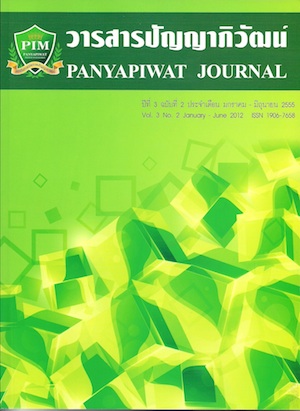การศึกษาเพื่อการประยุกต์ใช้ทฤษฎีแถวคอยในร้านค้าปลีกรูปแบบใหม่
Main Article Content
Abstract
บทคัดย่อ
งานวิจัยฉบับนี้ได้ศึกษาระบบการชำระค่าสินค้าของร้านค้าปลีกสมัยใหม่ จำนวน 4 สาขาในเขต กรุงเทพฯและปริมณฑล ช่วงเวลาที่มีผู้รับบริการเข้ามาซื้อสินค้าเป็นจำนวนมากในแต่ละวัน โดยได้ จำลองแบบตามจำนวนหน่วยให้บริการต่างๆ เพื่อนำมาประเมินประสิทธิภาพของระบบจาก เวลา รอรับบริการเฉลี่ย จำนวนผู้รอรับบริการเฉลี่ยในแถว และสัดส่วนเวลาว่างของหน่วยให้บริการ ซึ่งผลการจำลองแบบ อย่างอิสระกัน 100 ครั้ง แสดงให้เห็นว่า สาขาที่หนึ่ง มีเวลารอคอยเฉลี่ย ของผู้รับบริการเฉพาะระบบที่ 1 ไม่ต่างจากระบบที่ 2 และ 3 อย่างมีนัยสำคัญ (P>0.01) สาขา ที่สอง พบว่า เวลารอรับบริการเฉลี่ยทุกระบบไม่มีความแตกต่างกันอย่างมีนัยสำคัญทางสถิติ (P>0.01) แต่จำนวนผู้รับบริการเฉลี่ยในแถวทุกระบบมีค่าแตกต่างกันอย่างมีนัยสำคัญ (P<0.01) และจำนวนสัดส่วนเวลาว่างเฉพาะระบบที่ 1 กับระบบที่ 2 เท่านั้นที่ไม่แตกต่างกันอย่างมีนัยสำคัญ ทางสถิติ สาขาที่สาม พบว่าเฉพาะเวลารอรับบริการเฉลี่ยของระบบที่ 1 กับระบบอื่นเท่านั้น ที่มีความแตกต่างอย่างมีนัยสำคัญทางสถิติ (P<0.01) และเฉพาะสัดส่วนเวลาว่างของระบบที่ 2 และ 3 เท่านั้นที่มีค่าไม่ต่างกันอย่างมีนัยสำคัญทางสถิติ (P>0.01) และที่ สาขาที่สี่ พบว่าไม่มีความแตกต่างกันระหว่างเวลารอรับบริการเฉลี่ยในระบบที่ 1 และ 2 อย่างมีนัยสำคัญ (P>0.01) ในขณะที่ จำนวนผู้รอรับบริการเฉลี่ยในทุกระบบมีความแตกต่างกันอย่างมีนัยสำคัญ (P<0.01) และพบว่า สัดส่วนเวลาว่างของระบบที่ 1 กับระบบที่ 2 ระบบที่ 2 กับระบบที่ 3 และระบบที่ 3 กับระบบที่ 4 มีค่าแตกต่างกันอย่างมีนัยสำคัญ (P>0.05) หรืออาจกล่าวได้ว่าการเพิ่มขึ้นของหน่วยให้บริการทุกๆ หนึ่งหน่วยจะไม่ทำให้สัดส่วนเวลาว่างมีค่าเปลี่ยนแปลง
คำสำคัญ: ทฤษฎีแถวคอย การจำลองระบบ ร้านค้าปลีกรูปแบบใหม่
Abstract
This research is to study the Modern Trade’s payment system for 4 branches in Bangkok metropolitan areas at the peak time. The Models were simulated in order to compare their efficiency of average waiting time, average customers in queue and ratio of idle servers. The result gathered from 100 independent simulation times showed that for the first branch, there was no significant difference between averages waiting times of system 1 and system 2 and system 3 (P > 0.01). At the second branch, there was no significant difference between average waiting times for all systems (P>0.01) but there was significant difference between average customers in queue (P<0.01). In addition, the ratio of idle servers was no significantly difference between system 1 and system 2. The third branch, there was significant difference between averages waiting times of system 1 and the others (P<0.01). And the only ratio idle servers were no significant difference between system 2 and system 3 (P >0.01). And the fourth branch was no significant difference between only averages waiting times of system 1 and system 2 (P>0.01). There was significant difference between averages customers in queue for all systems (P<0.01). And there was no significant difference between the ratio idle servers of system 1 and system 2, system 2 and system 3, system 3 and system 4 (P>0.05) or addition every one sever did not change the ratio idle servers.
Keywords: Queuing Theory, Simulation, Modern Trade
Article Details
I and co-author(s) certify that articles of this proposal had not yet been published and is not in the process of publication in journals or other published sources. I and co-author accept the rules of the manuscript consideration. Both agree that the editors have the right to consider and make recommendations to the appropriate source. With this rights offering articles that have been published to Panyapiwat Institute of Management. If there is a claim of copyright infringement on the part of the text or graphics that appear in the article. I and co-author(s) agree on sole responsibility.
References
กัลยา วานิชย์บัญชา. (2550). การวิเคราะห์สถิติ: สถิติสำหรับการบริหารและวิจัย. กรุงเทพฯ: โรงพิมพ์แห่งจุฬาลงกรณ์มหาวิทยาลัย. มานพ วราภักดิ์. (2552). การวิจัยดำเนินการ. กรุงเทพฯ: โรงพิมพ์แห่งจุฬาลงกรณ์มหาวิทยาลัย.
วิมลวรรณ ปัทมรัตน์. (2545). การวิเคราะห์ระบบแถวคอยในการให้บริการลูกค้าของที่ทำการไปรษณีย์โทรเลข.วิทยาศาสตรมหาบัณฑิต, มหาวิทยาลัยเกษตรศาสตร์.
ศิริจันทร์ ทองประเสริฐ. (2542). สถิติสำหรับงานวิศวกรรม. กรุงเทพฯ: โรงพิมพ์แห่งจุฬาลงกรณ์มหาวิทยาลัย.
สายสุรางค์ โชติพานิช. (2547). การวิเคราะห์ระบบแถวคอยของการเข้ารับบริการเจาะเลือดโรงพยาบาลภูมิพลอดุลยเดช. กรุงเทพฯ: มหาวิทยาลัยเกษตรศาสตร์.
Sadiku, Matthew N.O. (2007). A tutorial on simulation of queuing models. Electrical Engineering Education, 9(36), 102-120.Shannon, R.E. (1975). Systems simulation: The art and science. New York: Prentice-Hall.
Taha, H. A. (2007). Operations research: An introduction. Singapore: Pearson Education International.


